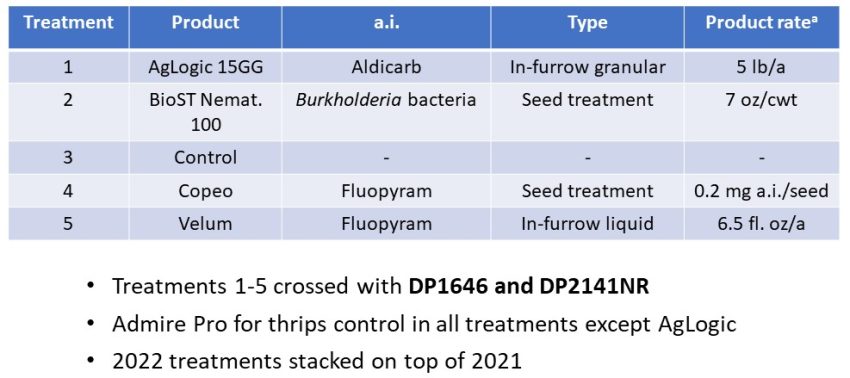Cotton cultivars with dual resistance to southern root-knot nematode and reniform nematode are relatively new tools for managing these two main nematode pests in cotton. While cultivars with resistance to root-knot nematode have been available for a few years, and have improved over time, cultivars with reniform nematode resistance were only released in the last few years. This is the third year we have tested some of these cultivars, so we have a pretty good picture of how they perform. The purpose of this article is to summarize this research to help guide nematode management choices in cotton.
Testing was conducted from 2021-2023 in replicated, small plot trials at NFREC in Quincy, Florida. Each trial had severe pressure from reniform nematode. We tested resistant cultivars adapted to the Southeast, including Deltapine 2141NR B3XF (DP 2141NR), Phytogen 411 W3FE (PHY 411), and Phytogen 443 W3FE (PHY 443). Deltapine and Phytogen cultivars were tested separately with DP 1646 B2XF and PHY 444 WRF serving as susceptible cultivars. Nematicide application is also a common nematode management practice, so various in-furrow or seed coating nematicide treatments were tested with Deltapine cultivars (Table 1). In-furrow Velum was also tested in combination with the PHY 444 susceptible cultivar.
Table 1. Resistant cultivar and nematicide treatments imposed in small plot trials at NFREC-Quincy conducted from 2021-2023
–
Resistant cultivars or AgLogic 15GG greatly reduce early season reniform nematode development
Reducing reniform nematode development on cotton roots earlier in the season is important for effectively protecting cotton yield from that nematode. Combined across trials, DP2141NR was consistently effective at managing reniform nematode infection, reducing abundances 94% relative to DP1646, both without nematicide (Figure 1, left). AgLogic 15GG was the only effective nematicide at managing reniform nematode at midseason, reducing abundances 84% relative to the susceptible cultivar without nematicide (Figure 1, left). Phytogen cultivars 411 and 443 also provided excellent reniform nematode control, but data is not shown in this article for brevity.

Figure 1. DP1646 susceptible and DP2141NR resistant cultivar and nematicides influenced midseason (6 weeks after planting) reniform nematode abundances on roots (left) and soil populations at harvest. Data is from 2021-2023 combined. Means with the same letter (within cultivar) are not significantly different. “*” indicates DP 2141NR significantly reduced RN at midseason and harvest.
–
Resistance provides season-long reniform nematode management
Resistant cultivars also greatly reduced reniform nematode soil abundances at harvest, with DP2141NR providing a 67% reduction relative to DP1646, both without nematicide (Figure 1, right). Phytogen cultivars (411 and 443) provided a similar reduction, but data is not shown. In contrast, AgLogic 15GG only reduced final reniform nematode counts by 25%. Perhaps the most important implication from this result is that resistant cultivars may have a carryover benefit for managing reniform nematode in the next crop, which would be especially helpful if cotton is the next crop.
–
DP2141NR resistant cultivar increases yield and improves income, on average
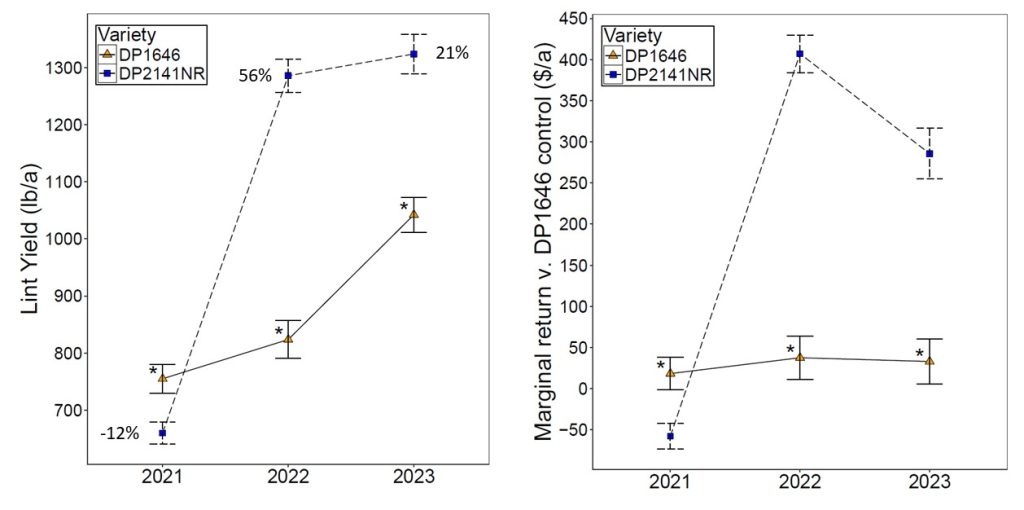
Figure 2. Cotton lint yield (left) and marginal return (right) for nematode resistant (DP2141NR) and susceptible (DP1646) cultivars in 2021, 2022, and 2023. Data is averaged across nematicide treatments. “*” indicates cultivar significantly affected yield each year. Marginal return is change in revenue minus change in product costs.
–
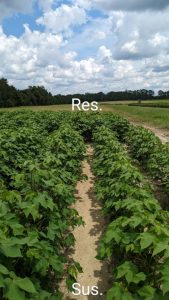
Figure 3. Increased plant canopy size with DP2141NR resistant cultivar (back) compared to DP1646 (front, reniform nematode susceptible). Photo by Zane Grabau, UF/IFAS.
Yield responses for DP2141NR resistant cultivar were somewhat variable, but it provided a big return on average. DP2141NR reduced yield by 12% in 2021, but increased yield 56% and 21% relative to DP1646 in 2022 and 2023, respectively (Figure 2, left). Each year, resistant cultivars had bigger cotton canopies than susceptible cultivars (Figure 3). It is likely that DP1646 has better yield potential than DP2141NR, which lead to the results in 2021, although other environmental factors could have contributed. Growing DP2141NR increased marginal return (change in revenue minus change in product costs) by roughly $400/acre and $300/acre in 2022 and 2023, while decreasing it by $50/acre relative to DP1646 in 2021 (Figure 2, right).
–
Phytogen 443 and 411 resistant cultivars consistently improve yield and income
Reniform nematode-resistant Phytogen cultivars (411 and 443) consistently increased yield relative to PHY444 (susceptible) with increases of 42% in 2021 and 45-56% in 2022. Similarly, resistant Phytogen cultivars provided a marginal return of $300/acre or more (Figure 5). My takeaway from the yield and economic data is that consistently using a resistant cultivar in fields with reniform nematode pressure is likely to provide a sizeable return, on average. Phytogen resistant cultivars may provide a more consistent return than Deltapine 2141NR.
–

Figure 4. Nematode-resistant Phytogen cotton cultivars (443 and 411) consistently increased cotton yield relative to susceptible cultivar (PHY444) with or without Velum.
–
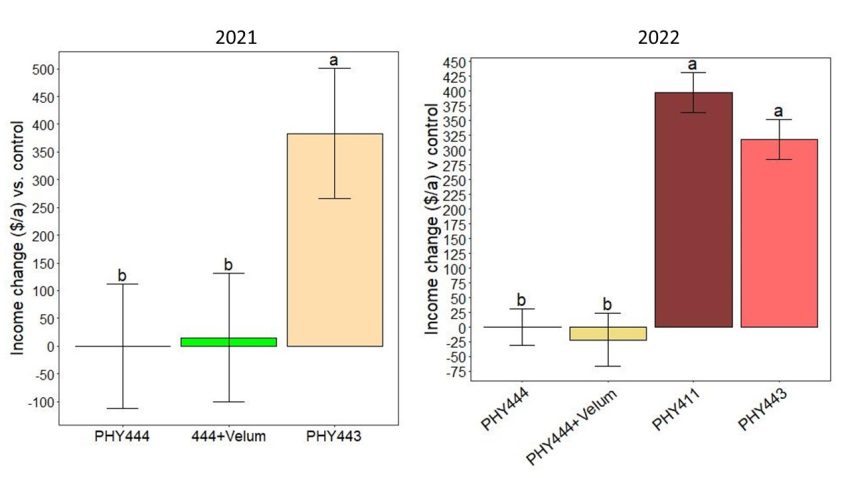
Figure 5. Nematode-resistant Phytogen cotton cultivars (443 and 411) consistently increased income relative to susceptible cultivar (PHY444) with or without Velum.
–
Some nematicides can also increase yield, but not as much as resistance
Either AgLogic 15GG or BioST seed treatment increased yield 9-16% relative to no nematicide (Figure 6, left). They also increased marginal return by roughly $35-75 relative to no nematicide, depending on the cultivar (Figure 6, right). Returns were less for nematicide application than resistant cultivars, but an effective nematicide improved returns (yield or income) even when a resistant cultivar was used. BioST yield benefits may be from a mechanism other than reniform nematode management (such as plant growth promotion), since it did not manage nematode abundances. Similarly, some of the yield benefits of AgLogic 15GG may be due to insect control.
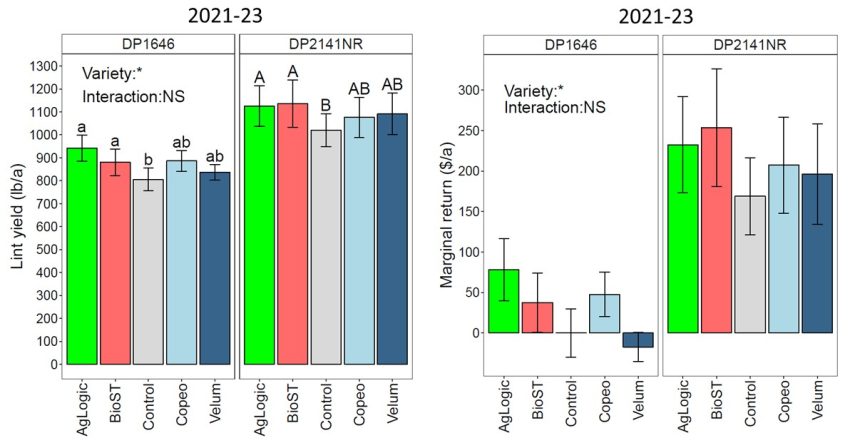
Figure 6. DP1646 susceptible and DP2141NR resistant cultivar and nematicides influenced lint yield (left) and marginal return (right). Data is from 2021-2023 combined. Means with the same letter (within cultivar) are not significantly different. “*” indicates DP2141NR significantly increased lint yield and marginal return.
–
Action items
- Sample your fields to check for the presence of plant-parasitic nematodes. This will help determine where nematode-resistant cotton cultivars or nematicides will be most useful. The UF/IFAS Nematode Assay Laboratory provides this service.
– - If you have fields with reniform nematode or root-knot nematode infestations, try a resistant cultivar. These cultivars have been tested against root-knot nematode in other states and they provided good control. As with any new practice, comparing a resistant cultivar on limited acreage relative to your current practice is a good first step.
– - If you have severe reniform nematode pressure and want to use a nematicide, try AgLogic 15GG in-furrow as it provided the best combination of yield return and reniform nematode control. To use AgLogic 15GG, growers must be set up for granular application and obtain a use permit as described in this publication: How to Obtain an Aldicarb Application Permit for Florida Cotton or Peanut.
–
For more information on nematode management in cotton, us the following publication link: Management of Plant-Parasitic Nematodes in Florida Cotton Production.
Thank you to The Cotton Foundation, Bayer Crop Science, Corteva Agriscience, and AgLogic Chemical Company for providing funds or materials for the trials in this article.

